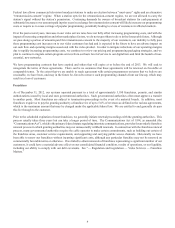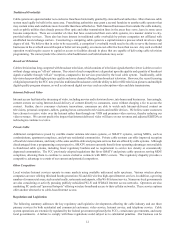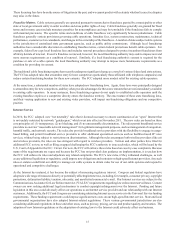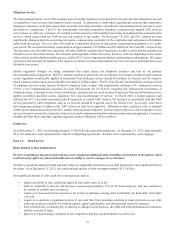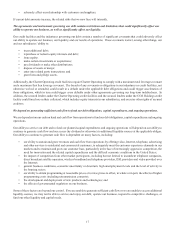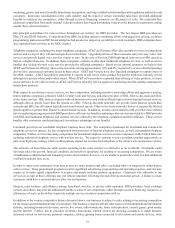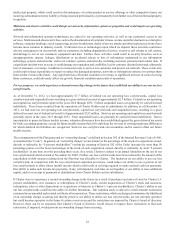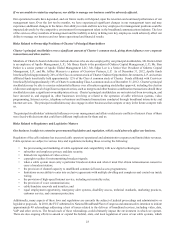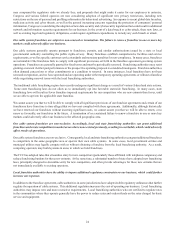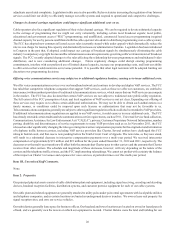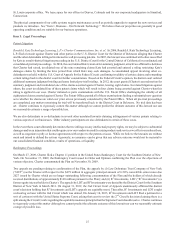Charter 2012 Annual Report Download - page 31
Download and view the complete annual report
Please find page 31 of the 2012 Charter annual report below. You can navigate through the pages in the report by either clicking on the pages listed below, or by using the keyword search tool below to find specific information within the annual report.19
marketing, greater and more favorable brand name recognition, and long-established relationships with regulatory authorities and
customers. Increasing consolidation in the cable industry and the repeal of certain ownership rules have provided additional
benefits to certain of our competitors, either through access to financing, resources, or efficiencies of scale. We could also face
additional competition from multi-channel video providers if they began distributing video over the Internet to customers residing
outside their current territories.
Our principal competitors for video services throughout our territory are DBS providers. The two largest DBS providers are
DirecTV and DISH Network. Competition from DBS, including intensive marketing efforts with aggressive pricing, exclusive
programming and increased HD broadcasting has had an adverse impact on our ability to retain customers. DBS companies have
also expanded their activities in the MDU market.
Telephone companies, including two major telephone companies, AT&T and Verizon, offer video and other services in competition
with us, and we expect they will increasingly do so in the future. Upgraded portions of these networks carry two-way video, data
services and provide digital voice services similar to ours. In the case of Verizon, FIOS high-speed data services offer speeds as
high as or higher than ours. In addition, these companies continue to offer their traditional telephone services, as well as service
bundles that include wireless voice services provided by affiliated companies. Based on our internal estimates, we believe that
AT&T and Verizon are offering video services in areas serving approximately 30% and 4%, respectively, of our estimated passings
and we have experienced customer losses in these areas. AT&T and Verizon have also launched campaigns to capture more of
the MDU market. AT&T has publicly stated that it expects to roll out its video product beyond the territories currently served
although it is unclear where and to what extent. When AT&T or Verizon have expanded their offering of video products, we have
seen a decrease in our video revenue as AT&T and Verizon typically roll out aggressive marketing and discounting campaigns to
launch their products.
With respect to our Internet access services, we face competition, including intensive marketing efforts and aggressive pricing,
from telephone companies, primarily AT&T, Century Link and Verizon, and other providers of DSL, fiber-to-the-node and fiber-
to-the-home services. DSL service competes with our Internet service and is often offered at prices lower than our Internet services,
although often at speeds lower than the speeds we offer. Fiber-to-the-node networks can provide faster Internet speeds than
conventional DSL, but still cannot typically match our Internet speeds. Fiber-to-the-home networks, however, can provide Internet
speeds equal to or greater than Charter's current Internet speeds. In addition, in many of our markets, DSL providers have entered
into co-marketing arrangements with DBS providers to offer service bundles combining video services provided by a DBS provider
with DSL and traditional telephone and wireless services offered by the telephone companies and their affiliates. These service
bundles offer customers similar pricing and convenience advantages as our bundles.
Continued growth in our residential telephone business faces risks. The competitive landscape for residential and commercial
telephone services is intense; we face competition from providers of Internet telephone services, as well as incumbent telephone
companies. Further, we face increasing competition for residential telephone services as more consumers in the United States are
replacing traditional telephone service with wireless service. We expect to continue to price our phone product aggressively as
part of our triple play strategy which could negatively impact our revenue from telephone to the extent we do not increase volume.
The existence of more than one cable system operating in the same territory is referred to as an overbuild. Overbuilds could
adversely affect our growth, financial condition, and results of operations, by creating or increasing competition. We are aware
of traditional overbuild situations impacting certain of our markets, however, we are unable to predict the extent to which additional
overbuild situations may occur.
In order to attract new customers, from time to time we make promotional offers, including offers of temporarily reduced price
or free service. These promotional programs result in significant advertising, programming and operating expenses, and also may
require us to make capital expenditures to acquire and install customer premise equipment. Customers who subscribe to our
services as a result of these offerings may not remain customers following the end of the promotional period. A failure to retain
customers could have a material adverse effect on our business.
Mergers, joint ventures, and alliances among franchised, wireless, or private cable operators, DBS providers, local exchange
carriers, and others, may provide additional benefits to some of our competitors, either through access to financing, resources, or
efficiencies of scale, or the ability to provide multiple services in direct competition with us.
In addition to the various competitive factors discussed above, our business is subject to risks relating to increasing competition
for the leisure and entertainment time of consumers. Our business competes with all other sources of entertainment and information
delivery, including broadcast television, movies, live events, radio broadcasts, home video products, console games, print media,
and the Internet. Further, due to consumer electronic innovations, content owners are allowing consumers to watch Internet-
delivered content on televisions, personal computers, tablets, gaming boxes connected to televisions and mobile devices, some


